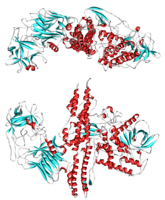
Photo from wikipedia
Background Myasthenia gravis is a rare autoimmune neuromuscular disorder. The disorder requires long-term use of expensive medication to control clinical symptoms. This study analyzed the change in trends of total… Click to show full abstract
Background Myasthenia gravis is a rare autoimmune neuromuscular disorder. The disorder requires long-term use of expensive medication to control clinical symptoms. This study analyzed the change in trends of total medical expenses and out-of-pocket expenses for patients with myasthenia gravis and explored the factors influencing them. Methods In this retrospective study, data were derived from a survey of medical service utilization for patients insured by the Urban Basic Medical Insurance in China from 2013 to 2015. The cost data of 3347 patients with myasthenia gravis were included in this study. The baseline characteristics and medical expenses for patients with myasthenia gravis were analyzed using a descriptive method. The difference and influencing factors of the out-of-pocket ratio were analyzed from both outpatient and inpatient expenses by using the quantile regression method. Results The total expenses reimbursed by the Urban Basic Medicine Insurance for all patients with myasthenia gravis fell progressively from 73.1 to 58.7% during the study period. Patients’ out-of-pocket expenses increased gradually, of which expenses within the scope of Basic Medicine Insurance increased from 14.7 to 22.6% and expenses outside of the Basic Medicine Insurance scope increased from 12.6 to 18.7%. Moreover, the panel quantile results showed a positive correlation between the year of receiving treatment and the out-of-pocket ratio. In addition to the 25th quantile of the out-of-pocket ratio among outpatients with myasthenia gravis, there were significant differences in medical insurance and medical institution among all the other quantiles. Significant regional differences were found in all quantiles of the out-of-pocket ratio, except for the 75th quantile among inpatients. Lastly, age had a negative effect on inpatients with myasthenia gravis across all quantiles, but not on outpatients. Conclusions From 2013 to 2015, patients with myasthenia gravis’s out-of-pocket expenses increased progressively. Moreover, the individual out-of-pocket ratio was affected by the year, medical insurance, medical institution, region, and age. The current medical insurance policy for the general public has a low ability to cater for patients with myasthenia gravis.
Journal Title: Orphanet Journal of Rare Diseases
Year Published: 2020
Link to full text (if available)
Share on Social Media: Sign Up to like & get
recommendations!